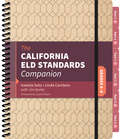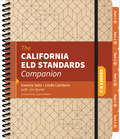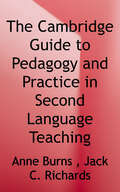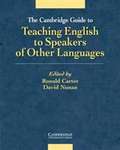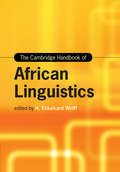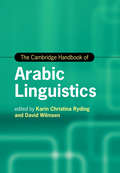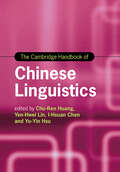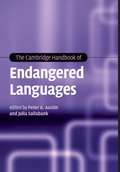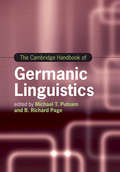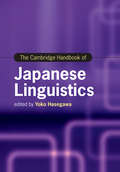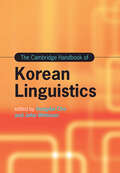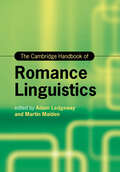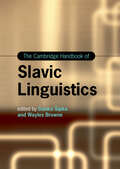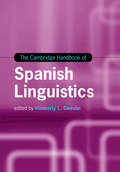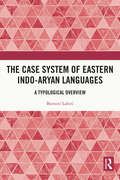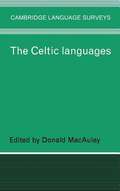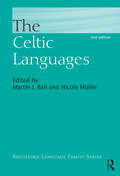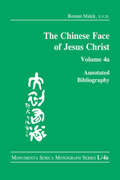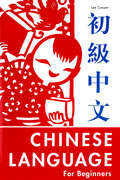- Table View
- List View
The California ELD Standards Companion: Grades 6-8
by Jim Burke Ivannia Soto Linda CarstensCalifornia teachers: you’re going to love this! Here at last is that single teaching resource for making the critical link between our ELD Standards and the CCSS ELA Standards. Standard by standard, you’ll quickly discover how to integrate language development into your day-to-day content instruction, armed with an insider’s understanding of how best to support our many English learners. Modeled after Jim Burke’s Common Core series, this Grades 6-8 volume of The California ELD Standards Companion is every bit “that version of the standards you wish you had” because it’s just so easy to digest and apply. It’s all here: Horizontal and vertical views reveal how each ELD Standard changes and progresses grade by grade and proficiency level by proficiency level. What the Student Does Sections, also scannable by grade and proficiency level, unpack in student-friendly language what meeting a standard looks like in practice. CCSS ELA Standards are displayed side by side with California’s ELD Standards so you can appreciate the purposeful alignment between the two as the basis for remodeling instructional practice. What the Teacher Does Sections provide specific instructional guidance by grade band, including student prompts and tips for differentiation across proficiency level. A dedicated vocabulary section offers a quick-reference glossary of key words and phrases as they are used within each ELD Standard. Each section concludes with a vignette from the California ELA/ELD Framework to illustrate exemplary standards-based instruction. Thanks to the ELD Standards, we are now free to teach our ELs the way we knew best all along: language and content taught hand in hand across the school day. Lean on Ivannia Soto and Linda Carstens’ California ELD Standards Companion as your one-stop guide for delivering that excellent education our ELs so deeply deserve.
The California ELD Standards Companion: Grades K-2
by Jim Burke Ivannia Soto Linda CarstensJust for California teachers! California teachers: you’re going to love this! Here at last is that single teaching resource for making the critical link between our ELD Standards and the CCSS ELA Standards. Standard by standard, you’ll quickly discover how to integrate language development into your day-to-day content instruction, armed with an insider’s understanding of how best to support our many English learners. Modeled after Jim Burke’s Common Core series, this Grades K-2 volume of The California ELD Standards Companion is every bit “that version of the standards you wish you had” because it’s just so easy to digest and apply. It’s all here: Horizontal and vertical views reveal how each ELD Standard changes and progresses grade by grade and proficiency level by proficiency level. What the Student Does Sections, also scannable by grade and proficiency level, unpack in student-friendly language what meeting a standard looks like in practice. CCSS ELA Standards are displayed side by side with California’s ELD Standards so you can appreciate the purposeful alignment between the two as the basis for remodeling instructional practice. What the Teacher Does Sections provide specific instructional guidance by grade band, including student prompts and tips for differentiation across proficiency level. A dedicated vocabulary section offers a quick-reference glossary of key words and phrases as they are used within each ELD Standard. Each section concludes with a vignette from the California ELA/ELD Framework to illustrate exemplary standards-based instruction. Thanks to the ELD Standards, we are now free to teach our ELs the way we knew best all along: language and content taught hand in hand across the school day. Lean on Ivannia Soto and Linda Carstens’ California ELD Standards Companion as your one-stop guide for delivering that excellent education our ELs so deeply deserve.
The California ELD Standards Companion: Grades K-2
by Jim Burke Ivannia Soto Linda CarstensJust for California teachers! California teachers: you’re going to love this! Here at last is that single teaching resource for making the critical link between our ELD Standards and the CCSS ELA Standards. Standard by standard, you’ll quickly discover how to integrate language development into your day-to-day content instruction, armed with an insider’s understanding of how best to support our many English learners. Modeled after Jim Burke’s Common Core series, this Grades K-2 volume of The California ELD Standards Companion is every bit “that version of the standards you wish you had” because it’s just so easy to digest and apply. It’s all here: Horizontal and vertical views reveal how each ELD Standard changes and progresses grade by grade and proficiency level by proficiency level. What the Student Does Sections, also scannable by grade and proficiency level, unpack in student-friendly language what meeting a standard looks like in practice. CCSS ELA Standards are displayed side by side with California’s ELD Standards so you can appreciate the purposeful alignment between the two as the basis for remodeling instructional practice. What the Teacher Does Sections provide specific instructional guidance by grade band, including student prompts and tips for differentiation across proficiency level. A dedicated vocabulary section offers a quick-reference glossary of key words and phrases as they are used within each ELD Standard. Each section concludes with a vignette from the California ELA/ELD Framework to illustrate exemplary standards-based instruction. Thanks to the ELD Standards, we are now free to teach our ELs the way we knew best all along: language and content taught hand in hand across the school day. Lean on Ivannia Soto and Linda Carstens’ California ELD Standards Companion as your one-stop guide for delivering that excellent education our ELs so deeply deserve.
The Cambridge Guide to Pedagogy and Practice in Second Language Teaching
by Jack C. Richards Anne BurnsThis collection of original articles provides a state-of-the-art overview of key issues and approaches in contemporary language teaching. <p><p>Written by internationally prominent researchers, educators, and emerging scholars, the chapters are grouped into five sections: rethinking our understanding of teaching, learner diversity and classroom learning, pedagogical approaches and practices, components of the curriculum, and media and materials. <p><p>Each chapter covers key topics in teaching methodology such as reflective pedagogy, teaching large classes, outcomes-based language learning, speaking instruction, and technology in the classroom. Chapters assume no particular background knowledge and are written in an accessible style.
The Cambridge Guide to Teaching English to Speakers of Other Languages
by Ronald CarterThis important book, with 32 chapters by leading figures in the field, is an up-to-date guide to the central areas of applied linguistics and language studies with particular reference to TESOL. It looks at the current state of TESOL as well as at what is likely to happen in the future.
The Cambridge Handbook of African Linguistics (Cambridge Handbooks in Language and Linguistics)
by H. Ekkehard WolffThis book provides an in-depth and comprehensive state-of-the-art study of 'African languages' and 'language in Africa' since its beginnings as a 'colonial science' at the turn of the twentieth century in Europe. Compiled by 56 internationally renowned scholars, this ground breaking study looks at past and current research on 'African languages' and 'language in Africa' under the impact of paradigmatic changes from 'colonial' to 'postcolonial' perspectives. It addresses current trends in the study of the role and functions of language, African and other, in pre- and postcolonial African societies. Highlighting the central role that the 'language factor' plays in postcolonial transformation processes of sociocultural modernization and economic development, it also addresses more recent, particularly urban, patterns of communication, and outlines applied dimensions of digitalization and human language technology.
The Cambridge Handbook of Arabic Linguistics (Cambridge Handbooks in Language and Linguistics)
by Karin Christina Ryding David WilmsenArabic linguistics encompasses a range of language forms and functions from formal to informal, classical to contemporary, written to spoken, all of which have vastly different research traditions. Recently however, the increasing prominence of new methodologies such as corpus linguistics and sociolinguistics have allowed Arabic linguistics to be studied from multiple perspectives, revealing key discoveries about the nature of Arabic-in-use and deeper knowledge of traditional fields of study. With contributions from internationally renowned experts on the language, this handbook provides a state-of-the-art overview of both traditional and modern topics in Arabic linguistics. Chapters are divided into six thematic areas: applied Arabic linguistics, variation and sociolinguistics, theoretical studies, computational and corpus linguistics, new media studies and Arabic linguistics in literature and translation. It is an essential resource for students and researchers wishing to explore the exciting and rapidly moving field of Arabic linguistics.
The Cambridge Handbook of Chinese Linguistics (Cambridge Handbooks in Language and Linguistics)
by Yu-Yin HsuThe linguistic study of Chinese, with its rich morphological, syntactic and prosodic/tonal structures, its complex writing system, and its diverse socio-historical background, is already a long-established and vast research area. With contributions from internationally renowned experts in the field, this Handbook provides a state-of-the-art survey of the central issues in Chinese linguistics. Chapters are divided into four thematic areas: writing systems and the neuro-cognitive processing of Chinese, morpho-lexical structures, phonetic and phonological characteristics, and issues in syntax, semantics, pragmatics, and discourse. By following a context-driven approach, it shows how theoretical issues in Chinese linguistics can be resolved with empirical evidence and argumentation, and provides a range of different perspectives. Its dialectical design sets a state-of-the-art benchmark for research in a wide range of interdisciplinary and cross-lingual studies involving the Chinese language. It is an essential resource for students and researchers wishing to explore the fascinating field of Chinese linguistics.
The Cambridge Handbook of Endangered Languages
by Peter K. Austin Julia SallabankIt is generally agreed that about 7,000 languages are spoken across the world today and at least half may no longer be spoken by the end of this century. This state-of-the-art Handbook examines the reasons behind this dramatic loss of linguistic diversity, why it matters, and what can be done to document and support endangered languages. The volume is relevant not only to researchers in language endangerment, language shift and language death, but to anyone interested in the languages and cultures of the world. It is accessible both to specialists and non-specialists: researchers will find cutting-edge contributions from acknowledged experts in their fields, while students, activists and other interested readers will find a wealth of readable yet thorough and up-to-date information.
The Cambridge Handbook of Germanic Linguistics (Cambridge Handbooks in Language and Linguistics)
by Michael T. Putnam B. Richard PageThe Germanic language family ranges from national languages with standardized varieties, including German, Dutch and Danish, to minority languages with relatively few speakers, such as Frisian, Yiddish and Pennsylvania German. Written by internationally renowned experts of Germanic linguistics, this Handbook provides a detailed overview and analysis of the structure of modern Germanic languages and dialects. Organized thematically, it addresses key topics in the phonology, morphology, syntax, and semantics of standard and nonstandard varieties of Germanic languages from a comparative perspective. It also includes chapters on second language acquisition, heritage and minority languages, pidgins, and urban vernaculars. The first comprehensive survey of this vast topic, the Handbook is a vital resource for students and researchers investigating the Germanic family of languages and dialects.
The Cambridge Handbook of Japanese Linguistics (Cambridge Handbooks In Language And Linguistics)
by Yoko Hasegawa<P>The linguistic study of Japanese, with its rich syntactic and phonological structure, complex writing system, and diverse sociohistorical context, is a rapidly growing research area. This book, designed to serve as a concise reference for researchers interested in the Japanese language and in typological studies of language in general, explores diverse characteristics of Japanese that are particularly intriguing when compared with English and other European languages. It pays equal attention to the theoretical aspects and empirical phenomena from theory-neutral perspectives, and presents necessary theoretical terms in clear and easy language. <P>It consists of five thematic parts including sound system and lexicon, grammatical foundation and constructions, and pragmatics/sociolinguistics topics, with chapters that survey critical discussions arising in Japanese linguistics. The Cambridge Handbook of Japanese Linguistics will be welcomed by general linguists, and students and scholars working in linguistic typology, Japanese language, Japanese linguistics and Asian Studies.
The Cambridge Handbook of Korean Linguistics (Cambridge Handbooks in Language and Linguistics)
by John Whitman Sungdai ChoThe 'Korean wave' in music and film and Korea's rise to become the twelfth economic power in the world have boosted the world-wide popularity of Korean language study. The linguistic study of Korean, with its rich syntactic and phonological structure, complex writing system, and unique socio-historical context, is now a rapidly growing research area. Contributions from internationally renowned experts on the language provide a state-of-the-art overview of key current research in Korean language and linguistics. Chapters are divided into five thematic areas: phonetics and phonology, morphology and syntax, semantics and pragmatics, sociolinguistics and psycholinguistics, and language pedagogy. The Handbook includes cross-linguistic data to illuminate the features of Korean, and examples in Korean script, making it suitable for advanced students and researchers with or without prior knowledge of Korean linguistics. It is an essential resource for students and researchers wishing to explore the exciting and rapidly moving field of Korean linguistics.
The Cambridge Handbook of Romance Linguistics (Cambridge Handbooks in Language and Linguistics)
by Adam Ledgeway Martin MaidenThe Romance languages and dialects constitute a treasure trove of linguistic data of profound interest and significance. Data from the Romance languages have contributed extensively to our current empirical and theoretical understanding of phonetics, phonology, morphology, syntax, semantics, pragmatics, sociolinguistics, and historical linguistics. Written by a team of world-renowned scholars, this Handbook explores what we can learn about linguistics from the study of Romance languages, and how the body of comparative and historical data taken from them can be applied to linguistic study. It also offers insights into the diatopic and diachronic variation exhibited by the Romance family of languages, of a kind unparalleled for any other Western languages. By asking what Romance languages can do for linguistics, this Handbook is essential reading for all linguists interested in the insights that a knowledge of the Romance evidence can provide for general issues in linguistic theory.
The Cambridge Handbook of Slavic Linguistics (Cambridge Handbooks in Language and Linguistics)
by Danko Šipka Wayles BrowneThe linguistic study of the Slavic language family, with its rich syntactic and phonological structures, complex writing systems, and diverse socio-historical context, is a rapidly growing research area. Bringing together contributions from an international team of authors, this Handbook provides a systematic review of cutting-edge research in Slavic linguistics. It covers phonetics and phonology, morphology and syntax, lexicology, and sociolinguistics, and presents multiple theoretical perspectives, including synchronic and diachronic. Each chapter addresses a particular linguistic feature pertinent to Slavic languages, and covers the development of the feature from Proto-Slavic to present-day Slavic languages, the main findings in historical and ongoing research devoted to the feature, and a summary of the current state of the art in the field and what the directions of future research will be. Comprehensive yet accessible, it is essential reading for academic researchers and students in theoretical linguistics, linguistic typology, sociolinguistics and Slavic/East European Studies.
The Cambridge Handbook of Spanish Linguistics (Cambridge Handbooks in Language and Linguistics)
by Kimberly L. GeeslinA state-of-the-art, in-depth survey of the topics, approaches and theories in Spanish linguistics today. The language is researched from a number of different perspectives. This Handbook surveys the major advances and findings, with a special focus on recent accomplishments in the field. It provides an accurate and complete overview of research, as well as facilitating future directions. It encourages the reader to make connections between chapters and units, and promotes cross-theoretical dialogue. The contributions are by a wide range of specialists, writing on topics including corpus linguistics, phonology and phonetics, morphosyntax, pragmatics, the role of the speaker and speech context, language acquisition and grammaticalization. This is a must-have volume for researchers looking to contextualize their own research and for students seeking a one-stop resource on Spanish linguistics.
The Cambridge History of the Romance Languages
by Martin Maiden John Charles Smith Adam Ledgeway Martin Maiden John Charles SmithWhat is the origin of the Romance languages and how did they evolve? When and how did they become different from Latin, and from each other? Volume 2 of The Cambridge History of the Romance Languages offers fresh and original reflections on the principal questions and issues in the comparative external histories of the Romance languages. It is organised around the two key themes of influences and institutions, exploring the fundamental influence, of contact with and borrowing from, other languages (including Latin), and the cultural and institutional forces at work in the establishment of standard languages and norms of correctness. A perfect complement to the first volume, it offers an external history of the Romance languages combining data and theory to produce new and revealing perspectives on the shaping of the Romance languages.
The Cambridge History of the Romance Languages
by Martin Maiden John Charles Smith Adam Ledgeway Martin Maiden John Charles SmithWhat is the origin of the Romance languages and how did they evolve? When and how did they become different from Latin, and from each other? Volume 2 of The Cambridge History of the Romance Languages offers fresh and original reflections on the principal questions and issues in the comparative external histories of the Romance languages. It is organised around the two key themes of influences and institutions, exploring the fundamental influence, of contact with and borrowing from, other languages (including Latin), and the cultural and institutional forces at work in the establishment of standard languages and norms of correctness. A perfect complement to the first volume, it offers an external history of the Romance languages combining data and theory to produce new and revealing perspectives on the shaping of the Romance languages.
The Cambridge Old English Reader
by Richard MarsdenThis reader remains the only major new reader of Old English prose and verse in the past forty years. The second edition is extensively revised throughout, with the addition of a new 'Beginning Old English' section for newcomers to the Old English language, along with a new extract from Beowulf. The fifty-seven individual texts include established favourites such as The Battle of Maldon and Wulfstan's Sermon of the Wolf, as well as others not otherwise readily available, such as an extract from Apollonius of Tyre. Modern English glosses for every prose-passage and poem are provided on the same page as the text, along with extensive notes. A succinct reference grammar is appended, along with guides to pronunciation and to grammatical terminology. A comprehensive glossary lists and analyses all the Old English words that occur in the book. Headnotes to each of the six text sections, and to every individual text, establish their literary and historical contexts, and illustrate the rich cultural variety of Anglo-Saxon England. This second edition is an accessible and scholarly introduction to Old English.
The Case System of Eastern Indo-Aryan Languages: A Typological Overview
by Bornini LahiriThis book presents a typological overview of the case system of Eastern Indo-Aryan (EIA) languages. It utilizes a cognitive framework to analyse and compare the case markers of seven EIA languages: Angika, Asamiya, Bhojpuri, Bangla, Magahi, Maithili and Odia. The book introduces semantic maps, which have hitherto not been used for Indian languages, to plot the scope of different case markers and facilitate cross-linguistic comparison of these languages. It also offers a detailed questionnaire specially designed for fieldwork and data collection which will be extremely useful to researchers involved in the study of case. A unique look into the linguistic traditions of South Asia, the book will be indispensable to academicians, researchers, and students of language studies, linguistics, literature, cognitive science, psychology, language technologies and South Asian studies. It will also be useful for linguists, typologists, grammarians and those interested in the study of Indian languages.
The Celtic Languages
by Donald MacaulayThis volume describes the six modern Celtic languages. Four of these, Modern Irish, Scottish Gaelic, Welsh and Breton, are living community languages; the other two, Manx and Cornish, survived into the modern period, but are no longer extant as community languages, though they are the subject of enthusiastic revivals. The Celtic languages sets them briefly in their Indo-European context, and states their general relationships within the broader Celtic language family. Individual linguistic studies are first placed briefly in their sociolinguistic and sociohistorical context. A detailed synchronic account of each language then follows, including syntax, morphology, phonology, morphophonology, dialect variation and distribution. Each description is based on a common plan, thus facilitating comparison amongst the different languages. This latest volume in the Cambridge Language Surveys will be welcomed by all scholars of the Celtic languages, but has also been designed to be accessible to any reader with only a basic knowledge of linguistics. It is the only modern account to deal with all surviving Celtic languages in this detail.
The Celtic Languages: Readings In The Brythonic Languages, Festschrift For T. Arwyn Watkins (Routledge Language Family Series #68)
by Martin J. Ball Nicole MüllerThe Celtic Languages describes in depth all the Celtic languages from historical, structural and sociolinguistic perspectives with individual chapters on Irish, Scottish Gaelic, Manx, Welsh, Breton and Cornish. This second edition has been thoroughly revised to provide a comprehensive and up-to-date account of the modern Celtic languages and their current sociolinguistic status along with complete descriptions of the historical languages. This comprehensive volume is arranged in four parts. The first part offers a description of the typological aspects of the Celtic languages followed by a scene setting historical account of the emergence of these languages. Chapters devoted to Continental Celtic, Old and Middle Irish, and Old and Middle Welsh follow. Parts two and three are devoted to linguistic descriptions of the contemporary languages. Part two has chapters on Irish, Scots Gaelic and Manx, while Part three covers Welsh, Breton and Cornish. Part four is devoted to the sociolinguistic situation of the four contemporary Celtic languages and a final chapter describes the status of the two revived languages Cornish and Manx. With contributions from a variety of scholars of the highest reputation, The Celtic Languages continues to be an invaluable tool for both students and teachers of linguistics, especially those with an interest in typology, language universals and the unique sociolinguistic position which the Celtic languages occupy. Dr Martin J. Ball is Hawthorne-BoRSF Endowed Professor, and Director of the Hawthorne Research Center, at the University of Louisiana at Lafayette. Dr Ball has over 120 academic publications. Among his books are The Use of Welsh, Mutation in Welsh, and Welsh Phonetics. Dr Nicole Müller is Hawthorne-BoRSF Endowed Professor at the University of Louisiana at Lafayette. Among her books are Mutation in Welsh, and Agents in Early Irish and Early Welsh.
The Chinese Face of Jesus Christ: Annotated Bibliography: volume 4a (Monumenta Serica Monograph Ser.)
by Roman MalekThis volume provides an annotated bibliography of the Western and Chinese literature on Jesus Christ in China. It is a sequel to the interdisciplinary collection on the manifold faces and images of Jesus throughout Chinese history, from the Tang dynasty (618�907) to the present time.The present bibliography broadens and deepens the above-mentioned subject matter, and also points out aspects which have been addressed in the contributions and anthologies of the previous volumes of The Chinese Face of Jesus Christ, but which have not been treated thoroughly. Another aim of this bibliography is to initiate and enable further research, particularly in China. It includes bibliographical data from the beginning of the introduction of Christianity to China until the year 2013, occasionally also until 2014. A list of �Key References� enables the reader to identify important works on main topics related to Jesus Christ in China. Some examples of book covers and title pages are included in the section of �Illustrations.�Other volumes of the collection The Chinese Face of Jesus Christ are in preparation: Vol. 3c will present longer quotations from the sources listed in the present bibliography, Vol. 4b will contain a general index with glossary, and Vol. 5 will deal with the iconography of Jesus Christ in China.
The Chinese Language for Beginners
by Lee CooperA simple introduction to Chinese writing, pronunciation and intonation using short stories. Appropriate for all ages.Reading basic Chinese becomes simplified in this highly attractive and unusual manual designed for readers of all ages. Chinese writing, pronunciation, and vocabulary are described here in an entertaining and interesting manner to help beginners learn quickly. The author starts with simple characters and then combines these to make sentences and stories. This step-by-step process allows the reader to develop a basic knowledge of the complex Chinese language with maximum comprehension. A section dealing with pronunciation and intonation and a vocabulary list of the characters used in the book are included as an aid for he reader. Beautiful, imaginative Chinese characters, hand painted by a professional calligrapher and amusing illustrations by the author supplement the text and make learning to read Chinese fun along with fancy.
The Chinese Language for Beginners
by Lee CooperA simple introduction to Chinese writing, pronunciation and intonation using short stories. Appropriate for all ages.Reading basic Chinese becomes simplified in this highly attractive and unusual manual designed for readers of all ages. Chinese writing, pronunciation, and vocabulary are described here in an entertaining and interesting manner to help beginners learn quickly. The author starts with simple characters and then combines these to make sentences and stories. This step-by-step process allows the reader to develop a basic knowledge of the complex Chinese language with maximum comprehension. A section dealing with pronunciation and intonation and a vocabulary list of the characters used in the book are included as an aid for he reader. Beautiful, imaginative Chinese characters, hand painted by a professional calligrapher and amusing illustrations by the author supplement the text and make learning to read Chinese fun along with fancy.
The Chinese Language for Beginners
by Lee CooperA simple introduction to Chinese writing, pronunciation and intonation using short stories. Appropriate for all ages.Reading basic Chinese becomes simplified in this highly attractive and unusual manual designed for readers of all ages. Chinese writing, pronunciation, and vocabulary are described here in an entertaining and interesting manner to help beginners learn quickly. The author starts with simple characters and then combines these to make sentences and stories. This step-by-step process allows the reader to develop a basic knowledge of the complex Chinese language with maximum comprehension. A section dealing with pronunciation and intonation and a vocabulary list of the characters used in the book are included as an aid for he reader. Beautiful, imaginative Chinese characters, hand painted by a professional calligrapher and amusing illustrations by the author supplement the text and make learning to read Chinese fun along with fancy.
